
欧洲公共空间发展史快速指南
What Happened to Public Space? A Quick Guide Through Europe’s History
由专筑网严越,杨帆编译
公共空间造就城市。他们是具有可见性和社交性的空间,这些区域好似无形的界限分隔了社会经济层,这是颇受争议的。优质公共空间的可用性是定义城市多样性的特征之一。市民只有在平等地访问和使用公共空间时,才会意识到自己作为社会成员的身份,这也是社会进化和成长的结果。为什么公共空间是城市的一个重要领域,它又是如何代表平等和民主的呢?
Public spaces make cities. They are the spaces of visibility and sociability, the areas where the invisible boundaries that separate us socio-economically are temporarily contested. The availability of quality public space is one of the varied characteristics that define the city. Citizens recognize themselves as members of a community only when they can equally access and use the public “place”, which also presents the result of evolution and growing up of the urban fabric. Why is public space such an essential area of cities and how it is translated in terms of equality and democracy?

古希腊集市在雅典的重建/Reconstruction of the Ancient Greek Agora in Athens
开始︰ 希腊集市
在古希腊城邦,集市作为中心聚集点,是政治、经济和社会生活的焦点。它的字面意思是"聚会场所"或"集会"。这是西方民主思想诞生的地方,对政治的讨论和参与,是民主治理的基本原则。起初,私人住宅围合成的中心地是集市,作为住房的延伸。后来,周边陆续建造起了寺庙和避难所,设立柱廊、人行道和门廊。
The Beginning: The Greek Agora
The Agora was the central spot in ancient Greek states, the focal point of the political, economic, and social life in the Greek polis. Its literal meaning is “gathering place” or “assembly”. It is where the idea of Western democracy was born, the arena of political deliberation and participation which are the fundamentals of democratic governance. At first, the Agora was surrounded by private houses being the extension of the home. Later, temples and sanctuaries were build bordering it with stoas, covered walkways, and porticoes.
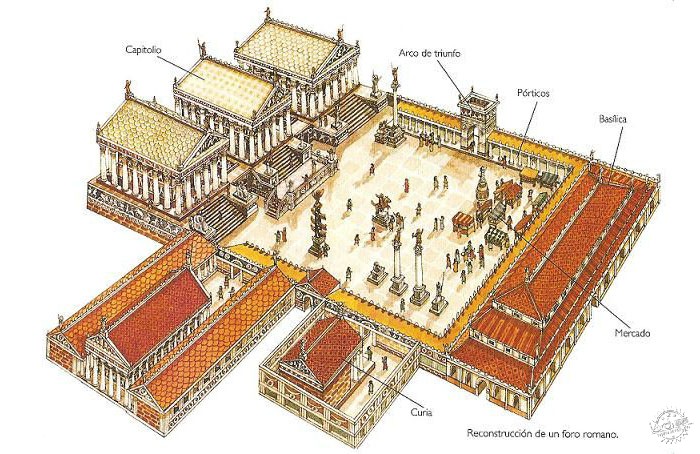
重建的罗马论坛/Reconstruction of The Roman Forum
罗马论坛
它和希腊的集市处于同时期,也可能受其影响,因为先前在伊特鲁里亚城市,没有这样类似的公共空间。论坛通常呈几何型,基本上是长方形,2个或三个排列出现,由柱廊环绕。场地可能包含了寺庙、长方形大教堂、商店和市场,因此融合了宗教和文娱活动的功能空间,包括剧院、公共浴室,以及教廷 (用于城市的市政会议) 和 comitium (政治会议)。之后论坛拥有了更多定义,形成了封闭独立的空间。
The Roman Forum
It is the parallel of the Greek Agora and probably influenced by it, as there is no trace of a similar public space in the earlier Etruscan cities. Forums usually have a geometric, basically rectangular shape, in a proportion of 2 to 3, surrounded by porticoes. They blended both religious and civic activities as they housed temples, basilicas, shops and markets. It was also common to find a theater and a public bath, as well as the curia (used for city council meetings) and comitium (political meeting). In later stages the Forums became more defined and enclosed, forming a series of separate spaces.
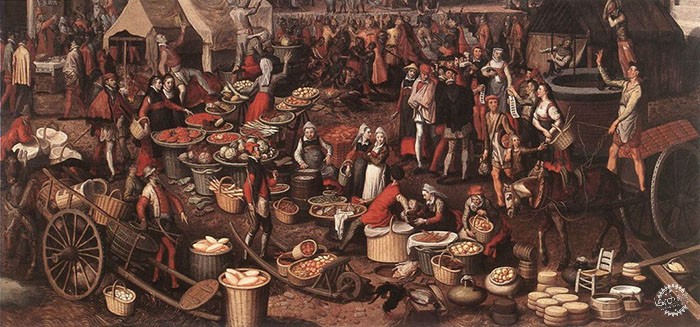
中世纪市场/The Middle Ages Marketplace
中世纪的集市广场
中世纪的城市主要为贸易。专门用于交易的市场作为城市的主要公共空间。大教堂是中世纪的主要机构,会持续举办不同的活动,交易市场就利用这一优势在周边不断发展。这也致使公共和私人空间之间的关系日趋紧张。城市竖起城壁抵抗侵略者,城墙内可供使用的空间资源有限,对私有土地的需求承受了巨大的压力。
The Medieval Market Square
The medieval city was a place of trade. One or more marketplaces were devoted to trading, as the main public spaces of the city. The cathedral was the main institution of the growing city of the Middle Ages, and the marketplace could often be found in an adjacent space, to take advantage of the constant activity. However, this is a time when the tension between public and private space started to emerge. Cities were walled for protection against invaders and the availability of space within the walls was limited, so there was a continuous pressure for claiming space for private use.
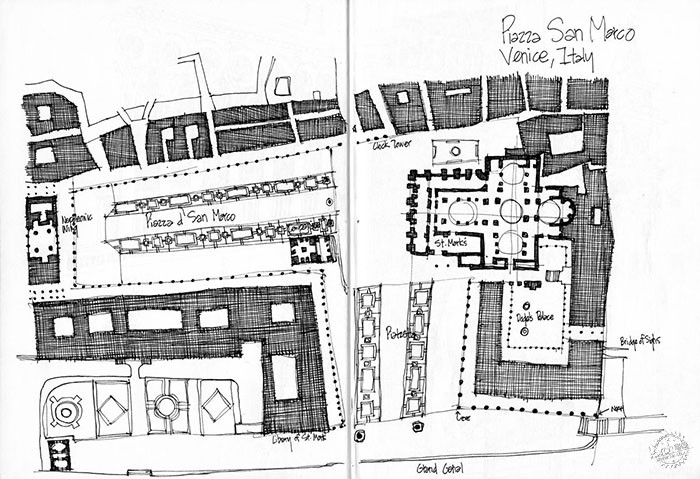
意大利威尼斯 圣马可广场/The San Marco Square in Venice, Italy
文艺复兴时期广场
文艺复兴和巴洛克式的广场都是经过精心规划的,工整的对称设计。正方形建筑统一风格的外立面强调着比例与和谐的重要性。这是一切改变的地方;围绕广场的居住区域-主要是为了上层阶级—形成了半公共的场所。
显然,这种对公共广场的限制访问使它们更受到开发商的欢迎。
The Renaissance Plaza
The Renaissance and the Baroque square was carefully planned, formally and symmetrically designed. The importance of proportion and harmony was visible in the uniform facades of the buildings surrounding these squares. This is when a new designing tradition begins: residential quarters around squares – primarily for the upper class – forming a semi-public character. Apparently, this ability to restrict public access to the use of these squares made them more popular among developers of new residential districts.
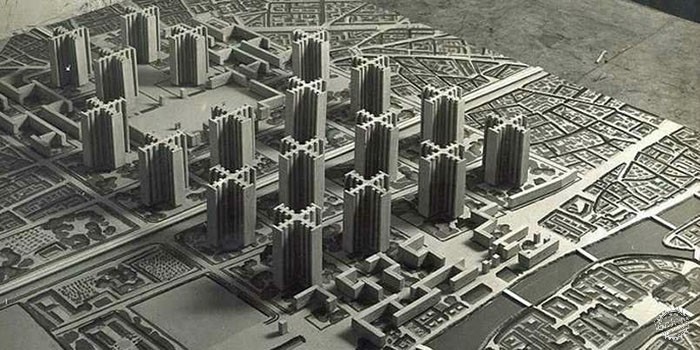
柯布西耶的巴黎规划/Le Corbusier’s Plan Voisin for Paris
现代主义中的公共空间
现代主义的座右铭:"形式服从功能"。功能主义者推崇汽车和快速移动的城市空间,渐渐破坏了公共空间及周围建筑的密切关系。城市和公共空间作为一个有组织的系统,遵循功能主义的发展原则。尽管现代主义者强调城市的集体利益,他们很少关注历史上的公共空间。城市的新愿景是扩大空间,以架设高层建筑,但却与其他地方失去了联系。缺少了这样的"失落空间"如何再进行社交?
The Public Space in Modernism
The era of the modernism is stigmatized with the motto: “Form Follows Function”. The functionalism of modernists, therefore, gave priority to cars and fast movement urban space, a notion that undermined the close relationship between open spaces and the building surrounding them. The city and its public space were designed as an organized system, where development ensued according to functionalist rules. Despite their emphasis on the primary of public interests in the city, the modernists paid little attention to the historically created public spaces. The new vision of the city was expanded open spaces where high buildings were erected, but with no other connection to the rest of the city. A “lost space” where sociability was impossible.
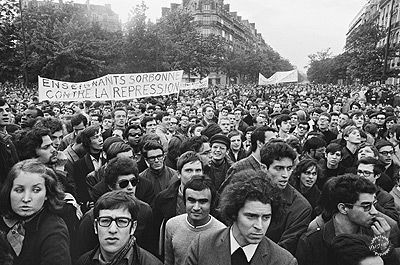
1968年5 月在巴黎的学生抗议活动/Students protesting in Paris, May ’68. Photograph: Serge Hambourg. Courtesy of Hood Museum of Art
公共空间和社会运动
政治不稳定时期,公共空间聚集了对社会不满的群众。在 1960 年社会和政治动乱频繁上演,还包括抗议横幅、涂鸦等。示威者偏好在公共空间(有时在私人空间)表达自己的不同意见。公民对应利用控制公共空间的意识在那时最为强烈,由此形成"城市权利"运动。
Public Space and Social Activism
Students protesting in Paris, May ’68. Photograph: Serge Hambourg. Courtesy of Hood Museum of Art
During times of political instability, the public space is charged as a vortex of social discontent. In the 1960’s social and political turmoils were frequently played out in public spaces, which were decorated with the language of protest (banners, murals, graffiti). Protestors frequently appropriated public spaces, and sometimes private ones, to voice their dissent. The notion that citizens can and should take control of open spaces was very vivid in these times, establishing the “right to the city” movement.
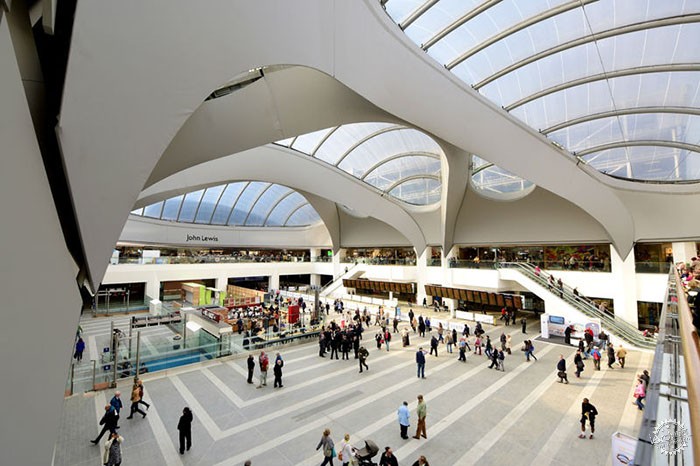
伯明翰中央购物中心/The Grand Central Shopping Mall in Birmingham
当代公共空间
在当代,城市中的公共空间受到资本和私有化的压力。这逐渐改变了其社会和物质上的形态,导致公共领域的大量减少和公共空间的缺失。公园绿地、露天广场和滨江路径在私有制下受到限制。没有明确区分公共和私人区域的综合性空间开始崭露头角,是一个"灰色地带"。这些空间”不承担任何象征性的表达,他们没有身份特征,通常是消费区,如咖啡店和购物商场。
城市公共空间的正确塑造反映了民主治理的正常运作。经过几个世纪的变革,我们现在站在需要处理公共空间遗留问题的时间点上。它们是城市转型的焦点。公共空间的成功不仅是依靠建筑师、城市设计师或城市规划师;它也需要人们适应、使用和管理 — — 人们造就空间,远大于空间对人的影响。
Contemporary Public Spaces
Public spaces in contemporary cities are under the pressure of capital and privatization. This is gradually transforming their social and physical form, leading to a significant reduction of the public realm and the loss of public space. Green parks, open-air squares, and riverside paths become victims of private ownership. A place of a hybrid character starts to emerge. It’s a place where there’s no clear distinction between public and private, a “gray area”. These non-places don’t bear any symbolic expression, they are devoid of identity and usually places of consumption, such as coffee shops and shopping malls.
The proper shaping of an urban public space reflects the proper functioning of a democratic governance. After so many transformations over the centuries, we are now at a point where we need to deal with theseleftovers of public space. They are the key focus in the transformation of the cities. The success of a particular public space is not solely in the hands of the architect, urban designer or town planner; it relies also on people adopting, using and managing the space – people make places, more than places make people.
参考书目/References
Bugari B., (2006). Transformation of public space, from modernism to consumerism. Urbani Izziv. Vol. 17, No. 1–2/06. pp. 173-176
Carr S., (1992). Public Space. Cambridge University Press. pp. 52-60, 68-70
Madanipour A., (20o3). Public and Private Spaces of The City. Routledge. pp. 193-220
Nissen S., (2008). Urban Transformation. From Public and Private Space to Spaces of Hybrid Character. Urban People/Lidé města. The University of Karlovy. pp. 1129-1149
出处:本文译自www.arch2o.com/,转载请注明出处。
|
|
